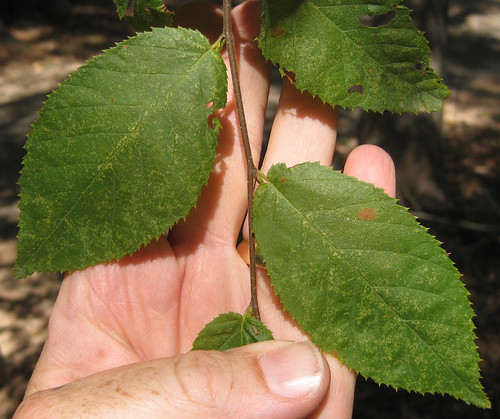Abundance: uncommon
What: seeds
How: raw, roasted, flour
Where: woods
When: late summer
Nutritional Value: calories
Dangers: none
Hornbeam "hops" in June. Alas, they won't make beer.
Close-up of seedhead consisting of overlapping samaras.
Ripe seedheads in September. Each samara holds a seed.

The trunk is gray, peeling, and rarely exceed 10" in diameter.
Note the edges of the leaves are finely serrated, the vein structure is pinnate, and the leaves alternate on the branch.

Texas distribution, attributed to U. S. Department of Agriculture. The marked counties are guidelines only. Plants may appear in other counties, especially if used in landscaping.
North American distribution, attributed to U. S. Department of Agriculture.
I often wonder what Texas beermakers think when they see hop hornbeam seedheads for the first time? Starting in midsummer these medium-sized trees are covered in what looks almost exactly like the hops used in brewing. These rather uncommon trees are usually found along the borders of woods where they are shaded by larger hardwoods but still can grab a bit of sun.
It's unusual seedhead clusters look very much like those of the beer-necessity hop vine. The leaves resemble elms but without the distinctive, directional hairs of the Ulmus (elm) species. The trunk, rarely exceeding 10" in diameter, appear to constantly be peeling their bark in narrow, cracked strips.
The seeds, though small, are plentiful are somewhat time consuming to collect. Regardless, they still were an important food source for Native Americans. The seeds have a mild, nutty flavor raw. Roasting them a bit makes them taste even better. Both the raw and roasted seeds can be boiled into a porridge or ground into a gluten-free flour.
Buy my book! Outdoor Adventure Guides Foraging covers 70 of North America's tastiest and easy to find wild edibles shown with the same big pictures as here on the Foraging Texas website.






